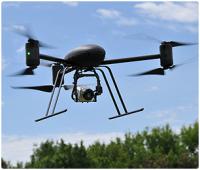-
Checking chemical detectors’ sensitivity to chemicals

The Joint Chemical Agent Detector (JCAD) has become an important defense tool on battlefields and in war-torn cities over the last few years. About the size and shape of a VHS tape or a hardcover bestselling novel, JCADs sound an alarm and begin to light up if nerve agents such as sarin or blister agents such as mustard gas are present. The detectors are already designed to withstand intense environments and repeated use. But when the Department of Defense wanted a way to check the devices’ sensitivity to chemicals over time, a measurement team at the National Institute of Standards and Technology (NIST) was called in to provide a cost-effective solution.
-
-
Interconnected technological risks: Responding to disruptions of cyber-physical systems
When infectious diseases strike, the World Health Organization acts swiftly, coordinating with the U.S. Centers for Disease Control and Prevention and its foreign counterparts to contain the threat. But there is no equivalent international organization similarly dedicated to identifying and mitigating a cyberattack. The World Economic Forum (WEF), however, is bringing together infrastructure and technology developers, insurers and government officials from across the globe to develop strategies for responding to interconnected technological risks, including those that can cascade when hackers disrupt cyber-physical systems.
-
-
Distant-scanning crowds for potential threats
Everyone wants to be safe and secure, but can you imagine if you had to go through a security screening at the metro station like there is at the airport? What if there were a way to safely scan crowds for potential threat items in places like metro and train stations without security officials coming into direct contact with the public and while maintaining individual privacy?
-
-
Call for proposals on advanced first responder technologies
Applications are now being accepted for the NextGen First Responder Technologies solicitation, an opportunity for a maximum conditional grant of up to $1 million, jointly funded by the DHS S&T and the Israel Ministry of Public Security (MOPS). the NextGen First Responder Technologies program is looking for innovations in fields such as protective clothing, wearable technology and situational awareness.
-
-
U.K. gov. launches £3M competition for innovative airport bomb-detection tech
Two U.K. government ministries — the Home Office and Department for Transport—have launched a Dragons’ Den-style investment prize, hoping to find innovative ways to detect bombs in laptops, phones, and cameras carried by passengers on board. The government has announced a £3 million competition in an effort to attract scientists and inventors to help the security services and the airline industry keep up with the nefarious ingenuity of terrorists.
-
-
AI used to limit collision-prone roadways
Could a traffic agency identify a potentially dangerous road intersection without first witnessing a collision? Researchers are attempting to answer that question as they near completion on a two-year proof-of-concept study to develop an image-based system for monitoring and assessing the safety of intersections.
-
-
Developing a secure, un-hackable net for quantum devices
To date, communicating via quantum networks has only been possible between two devices of known provenance that have been built securely. With the EU and the United Kingdom committing €1 billion and £270 million, respectively, into funding quantum technology research, a race is on to develop the first truly secure, large-scale network between cities that works for any quantum device.
-
-
Quantum speed limit may put brakes on quantum computers
Over the past five decades, standard computer processors have gotten increasingly faster. In recent years, however, the limits to that technology have become clear: Chip components can only get so small, and be packed only so closely together, before they overlap or short-circuit. If companies are to continue building ever-faster computers, something will need to change. One key hope for the future of increasingly fast computing is my own field, quantum physics. Quantum computers are expected to be much faster than anything the information age has developed so far. But my recent research has revealed that quantum computers will have limits of their own – and has suggested ways to figure out what those limits are.
-
-
Balloon-borne infrasound sensor array detects explosions
Infrasound is sound of very low frequencies, below 20 hertz, which is lower than humans can hear. African elephants produce infrasound for long-distance communication at around 15 hertz. For comparison, a bumblebee’s buzz is typically 150 hertz and humans hear in the range of 20 to 20,000 hertz. Infrasound is important because it’s one of the verification technologies the U.S. and the international community use to monitor explosions, including those caused by nuclear tests. Traditionally, infrasound is detected by ground-based sensor arrays, which don’t cover the open ocean and can be muddled by other noises, such as the wind. Sandia Lab scientists is using sheets of plastic, packing tape, some string, a little charcoal dust, and a white shoebox-size box to build a solar-powered hot air balloon for detecting infrasound.
-
-
Detect illicit drone video filming

Researchers have demonstrated the first technique to detect a drone camera illicitly capturing video. Their study addresses increasing concerns about the proliferation of drone use for personal and business applications and how it is impinging on privacy and safety.
-
-
Smart sensor could revolutionize crime, terrorism prevention
Crime, terrorism prevention, environmental monitoring, reusable electronics, medical diagnostics and food safety, are just a few of the far-reaching areas where a new chemical sensor could revolutionize progress. Engineers at the University of Oxford have used material compounds, known as Metal Organic Frameworks (MOFs), to develop technology that senses and responds to light and chemicals. The material visibly changes color depending on the substance detected.
-
-
Multi-channel, nonlinear-optical processing devices to reduce cost of high-speed internet connections
Breakthrough research could lead to a dramatic reduction in the cost and energy consumption of high-speed internet connections. Nonlinear-optical effects, such as intensity-dependent refractive index, can be used to process data thousands of times faster than what can be achieved electronically. Such processing has, until now, worked only for one optical beam at a time because the nonlinear-optical effects also cause unwanted inter-beam interaction, or crosstalk, when multiple light beams are present.
-
-
Innovative smart grid technology solves decades-old problematic power grid phenomenon
Picture a teeter-totter gently rocking back and forth, one side going up while the other goes down. When electricity travels long distances, it starts to behave in a similar fashion: the standard frequency of 60 cycles per second increases on the utility side of the transmission line while the frequency on the customer side decreases, switching back and forth every second or two. This phenomenon — called inter-area oscillations — can be a problem on hot summer days when the demand for power is high. Sandia National Laboratories and partners have demonstrated a control system that smooths out these oscillations using new smart grid technology. Sandia’s controls use real-time data to reduce inter-area oscillations on western grid.
-
-
Subterranean Challenge: Revolutionizing underground capabilities
Underground settings are becoming increasingly relevant to global security and safety. Rising populations and urbanization are requiring military and civilian first responders to perform their duties below ground in human-made tunnels, underground urban spaces, and natural cave networks. DARPA two weeks ago announced its newest challenge — the DARPA Subterranean Challenge – to accelerate development of critical lifesaving capabilities.
-
-
Innovative technologies for preventing cyberattacks
The Department of Energy’s Pacific Northwest National Laboratory has licensed three of its most unusual technologies for preventing cyberattacks to Cynash Inc., a startup company funded by IP Group, an intellectual property commercialization company. Cynash was formed specifically to bring these three cyber protection technologies to market to provide a powerful new approach to the detection and prevention of cyberattacks. Two of the technologies, DigitalAnts and MLSTONES, are inspired by nature and biology. The third, SerialTap, addresses vulnerabilities inherent in remotely controlled physical systems common in infrastructure and manufacturing.
-
More headlines
The long view
New Technology is Keeping the Skies Safe
DHS S&T Baggage, Cargo, and People Screening (BCP) Program develops state-of-the-art screening solutions to help secure airspace, communities, and borders
Factories First: Winning the Drone War Before It Starts
Wars are won by factories before they are won on the battlefield,Martin C. Feldmann writes, noting that the United States lacks the manufacturing depth for the coming drone age. Rectifying this situation “will take far more than procurement tweaks,” Feldmann writes. “It demands a national-level, wartime-scale industrial mobilization.”
How Artificial General Intelligence Could Affect the Rise and Fall of Nations
Visions for potential AGI futures: A new report from RAND aims to stimulate thinking among policymakers about possible impacts of the development of artificial general intelligence (AGI) on geopolitics and the world order.
Keeping the Lights on with Nuclear Waste: Radiochemistry Transforms Nuclear Waste into Strategic Materials
How UNLV radiochemistry is pioneering the future of energy in the Southwest by salvaging strategic materials from nuclear dumps –and making it safe.
Model Predicts Long-Term Effects of Nuclear Waste on Underground Disposal Systems
The simulations matched results from an underground lab experiment in Switzerland, suggesting modeling could be used to validate the safety of nuclear disposal sites.
